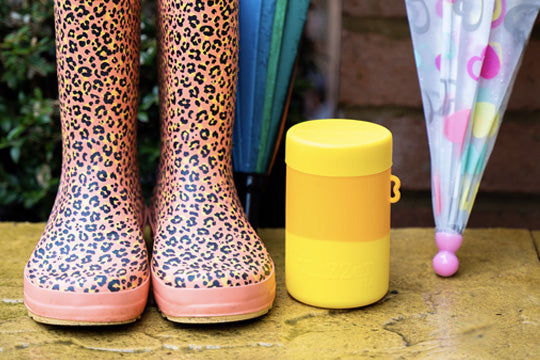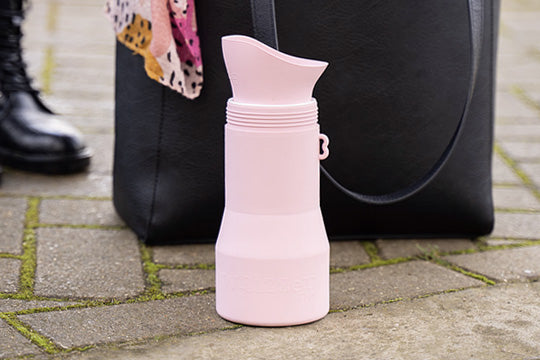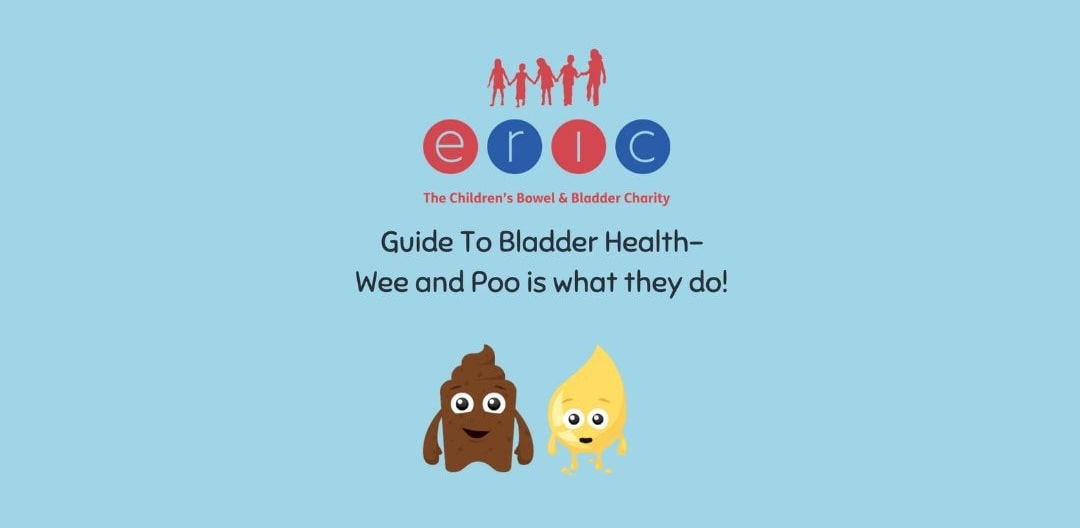Children’s bladder health: bladder problems and incontinence
How the bladder works
After eating and drinking, our body soaks up all the fluid and this goes into our bloodstream. The blood is then pumped through
ugh our kidneys which filter out the waste. This waste is known as urine or wee.
Urine travels down tubes called ureters into our bladder, which is a balloon shaped bag made of muscle. As it fills with urine and stretches, the bladder sends a message to our brain saying it’s time to do a wee.
Our brain controls the bladder by sending messages through the nerves in the spinal cord telling it when to hold on and when to empty.
Wee travels out of the bladder through a tube called the urethra. You release it by relaxing one set of ‘holding on’ muscles, whilst contracting another set of ‘squeezing’ muscles. It’s the holding on muscles which stop us from having a wetting accident on a long car journey after a big drink!
What is a healthy bladder?
Here are the signs your child’s bladder is working properly:
- A healthy bladder stores urine at low pressure and should be emptied between 4 – 7 times each day. This is around every 2 hours during the day.
- It can hold the correct amount depending on their age (see chart)
- Their bladder sends a signal to say when it’s full and gives a child enough time to find a toilet or potty.
- It empties fully each time they use the toilet and doesn’t leak, or dribble wee in between toilet trips.
Daytime bladder problems are common in children, especially in younger children after the potty training stage. Issues can range from:
- Sometimes needing to rush to the toilet (urgency),
- Doing lots of little wees (frequency),
- The occasional small accident or complete bladder emptying.
Healthy urine colour
When children drink enough, their wee should be light yellow. The darker the wee, the more dehydrated they are likely to be.
Take a look at our Wee Checker to keep an eye on their wee:

How much should children drink?
Children should have 6 – 8 water-based drinks each day. The size of the glass should be relative to your child’s age and size: about 200ml for a 7 year old and 250ml for an 11 year old.
This table suggests the total amount of water-based fluid for most children, during waking hours:
| AGE | VOLUME |
| 1-3 | 900-1000ml |
| 4-8 | 1000-1400ml |
| 9-13 | 1200-2100ml |
- The total amount of liquid that a child needs varies depending on their age, size, activity levels and environment. Hot weather, getting lots of exercise and being overweight all mean children need to drink more.
- Good drinking habits are important for concentration levels. It also helps to promote good bladder health, helps to prevent urinary tract infections (UTI) and constipation.
- If your child doesn’t like drinking plain water, then dilute squash or fruit juice is fine.
- Feeling thirsty can’t be relied on as a sign that children need to drink. This is because their thirst ‘cue’ may not be well developed. Or, they have reduced awareness of this sensation particularly if they have an additional need.
Baby’s bladders
- The amount your baby needs to wee can vary. Some babies urinate every one to three hours and others between four to six times a day.
- When a baby is poorly with a high temperature for example, or it’s hot weather, their usual output of urine may drop by half and still be normal.
- The colour of their wee can vary from very clear to dark yellow.
- Once you baby is fully weaned (eating solid food) it’s important they start to have their drinks in a regular pattern throughout the day. For example, encourage a drink with every meal and also another drink midway between meals.
- This regular fluid intake also helps with potty training.
How often should children wee?
- School aged children (5 and over) should empty their bladders between 4 and 7 times a day, or every 2/2.5 hours approx.
- Younger children need to wee more frequently. Their smaller bladders hold about 120mls of urine at 3 years and this increases in capacity by about 30mls a year. However, their kidneys produce urine at the same rate as older children’s kidneys (about 60mls an hour).
- It's common for children under 5 to get the message that their bladder needs emptying at a later stage. This means they need to use the toilet more often and at shorter notice.
- As children get older, and if their bladder is working well, they become aware of the need to pass urine before the bladder is full, giving them more time use the toilet at convenient intervals; such as at school break time.
Common bladder problems
Wee accidents are very common when children are potty training. However, if leaks are still happening over the age of 5 years, you should book an appointment with a doctor so it can be looked into.
There are different types of urinary incontinence:
- Doing lots of small wees (frequency) and/or needing to rush to the toilet (urgency). This is often called ‘bladder overactivity’.
- Daytime wetting – damp pants or full bladder empty
- Finding it hard to relax on the toilet and fully empty their bladder
- Structural problems with the bladder usually from birth, such as bladder exstrophy or if the ureters connect to the bladder in the wrong place.
- Other conditions such as Spina Bifida which affect a small number of children from birth. This means the messages between the bladder and brain don’t work properly so children don’t recognise the need to wee. Get more information on complex bladder conditions and how they can be managed.
- Night time accidents (bedwetting) are common in children who also have daytime problems. If your child wets the bed and also has accidents in the daytime, this need to be investigated and treated first.
Causes of children’s incontinence
Here are some of the different things that can affect the way a child’s bladder works:
- Most bladder issues in children will be caused by a functional problem. This means everything in your child’s bladder is in the right place and should be able to work properly.
- Underlying constipation is a common cause of bladder issues and needs to be ruled out. A full bowel can affect the space that the bladder needs to fill and empty properly. Read our factsheet Advice for Children with Constipation for information on how to treat poo problems.
- A urinary tract infection (UTI) can make peeing painful and urine smell. UTIs are common in children who have underlying constipation.
- Children with additional needs such as autism are more likely to be affected by constipation which can then cause problems with their bladder. They may also find it difficult to recognise thirst due to a sensory processing difference.
- Wee accidents are very common when children are potty training and learning how to manage their bladder. They usually clear up once your child goes to school.
- If children don’t drink enough, their wee can become concentrated. This can irritate their bladder and make it empty when it shouldn’t.
- Certain drinks can also irritate the bladder such as blackcurrant and drinks containing caffeine (cola, energy drinks, hot chocolate etc).
- Putting off going to toilet when you need to go (‘holding on’) makes it more likely an accident will happen.
How to treat incontinence in children
If you think your child has a bladder problem, book an appointment with your GP. They should assess your child and discuss possible treatment.
- The doctor should examine your child and ask questions to find out if the bladder problems could be caused by an underlying condition. This is rare, but it is important to check.
- Most bladder conditions can be sorted out by following some simple steps which are often described as ‘bladder training.’
- It is important to remember that children don’t have accidents on purpose. They’re not caused by laziness or naughtiness.
- Try to praise your child for any efforts they make to becoming dry, such as increasing the amount they drink each day.
Take a look at the ERIC factsheet on Advice for Children with Daytime Bladder Problems for more information on the causes, treatments and bladder training tips.
How to spot an overactive bladder
The bladder is supposed to stay soft and stretchy whilst it’s filling and until you get to the toilet. However, some children have an overactive or ‘twitchy’ bladder.
This means:
- A child's bladder signals that it's time to do a wee before the bladder is full. This means the bladder muscles contract before they are ready to empty.
- Because of this, you child will go to the toilet more often than other kids their age. They may find it hard to hold on until they get there and even leak urine on the way to the toilet.
- Children often do a ‘wee dance’ or hold themselves as an automatic response to the messages from the bladder, without realising this is what is happening.
What is the main cause of overactive bladder?
Bladder overactivity is one of the most common causes of daytime bladder and wetting problems in children. It can happen for a number of different reasons including:
- Being constipated. A full bowel can squash the bladder and make it hard to fill and hold on to wee. Constipation can then cause frequency, urgency and bladder infections.
- Not drinking enough. If you are not drinking enough your wee will be dark yellow in colour and very strong. Strong wee can irritate the lining of the bladder and make the twitching worse.
- The wrong drinks. Fizzy drinks and drinks with caffeine in them irritate the lining of the bladder. Tea, coffee, cola, hot chocolate and energy drinks all contain caffeine. If the bladder lining is irritated then the bladder twitching will get worse. This means your child will need to go to the toilet more often and have more wetting accidents.
- Not getting to the toilet in time. If you 'hold on' for too long, instead of going to the toilet when you feel you need to wee you are more likely to have a wetting accident.
- Urinary tract infections (UTI) can make you need to go to the toilet more often than usual and have to get there quickly.
Can an overactive bladder be cured?
Yes, bladder overactivity can be treated successfully and the bladder can start working normally.
There are several treatment options depending on the cause of the overactivity. Some of these may be used in combination.
- Before your child has a bladder assessment, it's helpful to keep a wee diary. Use the ERIC intake/output chart to record your child's weeing pattern and log much they’re drinking.
- If your child has any underlying constipation, this must be treated first.
- Medications called anticholinergics can be prescribed if there’s a lot of frequency and urgency. They work by reducing sensitivity in the bladder, stopping it twitching and help it to relax.Your doctor or bladder specialist will explain more about how they work, the different types and what the side effects can be.
- There are behavioural interventions to help with urinary incontinence. These include bladder retraining, pelvic floor exercises and biofeedback training. Your doctor can give you more information on these treatments.
Children’s UTI symptoms
Urinary tract infections can also cause bladder frequency and urgency. This means your child is more likely to need the toilet in a rush and not always get there on time.
The signs your child could have an infection in their bladder include:
- Doing lots of small wees more often than usual
- Needing to rush to the toilet urgently
- Daytime accidents and bedwetting
- Their wee might be smelly and/or cloudy
- Your child may complain of tummy ache or stingy wee. They may also have a high temperature.
- They may not seem ill however, so you wouldn’t guess your child had a UTI.
How to treat children’s UTI
If you think your child has a UTI, book an appointment with your doctor or nurse. There is a simple urine test that can be done to confirm an infection.
If an infection is found, they may need to take antibiotics to clear it up.
Some children need to stay on antibiotics until well after the UTI is better to help stop the infection coming back. A healthcare professional can explain more about this and do further tests if they think it’s necessary.
It’s really important to make sure your child changes their pants if they’re wet. Sore, damp skin can make UTIs more likely.
ERIC's New Toilet Training Campaign
With one in four children in England and Wales starting school not toilet trained, teachers are facing a huge challenge in September as new reception class children arrive untrained. In response, ERIC, The Children’s Bowel & Bladder Charity has launched a campaign to help families get their children ready for school over the summer holidays.
Toilet training can be more difficult now than in previous generations, due to many social and economic factors affecting families, and a lack of local continence services and advice to help people who are experiencing problems. ERIC, The Children’s Bowel & Bladder Charity is working to reverse the trend of later toilet training by offering non-judgmental, practical advice and a safe space for parents who may be facing external pressure and judgement.
ERIC, The Children’s Bowel & Bladder Charity runs a helpline for families experiencing bladder and bowel issues. For the past few years it has seen an increase in calls to the helpline, particularly from July onwards, from parents whose children are due to start school but aren’t ready.







